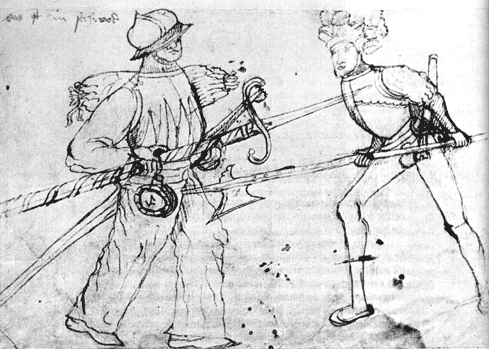Hi all, I am expanding my polearm colection and need info on a paticular weapon but don't know what its called.
i've seen it in woodcuts where Landsknecht are fighting Swedish footsoldiers, a kind of staff sword/ spear made from a sword blade with an "S" guard attached to a pole.
Dose anyone Know what its called or how its made?(I think it is made like a Japanese Polearm with the tang of the blade set into the shaft but I don't know for sure) I'd like to try and make one from sword parts next year.
If you could show us or provide a link to some of those woodcuts then that would help a lot.
They are shown in Paul Dolstein's pictures
 Attachment: 73.02 KB
Attachment: 73.02 KB


Hello Nathan,
I think this is what you are looking for: http://www.myArmoury.com/talk/viewtopic.php?t=1248
Peter Johnsson made one for the late Joachim Nillsson.
Best wishes,
Søren
I think this is what you are looking for: http://www.myArmoury.com/talk/viewtopic.php?t=1248
Peter Johnsson made one for the late Joachim Nillsson.
Best wishes,
Søren
Wow! are there any manuals or recorded techniques for those?
Yeah, that is an awesome polearm!
Yeah, that is an awesome polearm!
You'd probably be well served by Italian manuals covering the partizan. Silver might cover it but I don't recall.
| Sean Flynt wrote: |
| You'd probably be well served by Italian manuals covering the partizan. Silver might cover it but I don't recall. |
Really, any sort of manuals covering a polearm would work. Essentially, this weapon is a modified form of spear, so anything on the spear or staff would be relevant.
| Nathan Johnson wrote: |
| They are shown in Paul Dolstein's pictures |
Nothing quite like getting the top-spike of a halberd in the family jewels...
As for the Swede's polearm, Dolstein himself wrote that they were "made from swords" (see Landsknecht Soldier 1486-1560 by John Richards).
The ones I have seen (4-5) have all had specially forged blades, not re-used sword blades.
I do not doubt that sword blades were used, and perhaps on most.
There was an export from Passau to scandinavia of second rate blades. Many are type XX, in scandinavia commonly found on two handed swords with typical pretzel guard and apple shape pommel. Such blades could be useful as polearms, as they are quite thick and sturdy. Dolnstein would have recognized the Passau mark of the running wolf and the bishop staff.
It seems to me that the normal way to fit them would have been to cut the tang of the sword, and punch two or three holes in the forte of the sword. It was fitted into a slot in the pole. The S-curved guard has a tube shaped mid section. This reaches some two or three inches down over the pole. through this is driven rivets, passing through the whole construction.
This is the general principle construction as far as I can tell from surviving parts.
Some kind of reinforcing langets would also have been common. Straight, or as is suggested in Dolnsteins drawings: spiraling down the pole.
The blades I have seen have been of varying shape. Not as large as full sized swords. Often about 50-60 cm. One was broad and rather crudely made. Seems like it was forged in a village smithy. Another was more fancy: narrow, and of thick back-edge construction. It had a "ricasso" at the base and then one full length edge and one half length edge. More of a narrow thrusting point than a broad slashing one.
I do not doubt that sword blades were used, and perhaps on most.
There was an export from Passau to scandinavia of second rate blades. Many are type XX, in scandinavia commonly found on two handed swords with typical pretzel guard and apple shape pommel. Such blades could be useful as polearms, as they are quite thick and sturdy. Dolnstein would have recognized the Passau mark of the running wolf and the bishop staff.
It seems to me that the normal way to fit them would have been to cut the tang of the sword, and punch two or three holes in the forte of the sword. It was fitted into a slot in the pole. The S-curved guard has a tube shaped mid section. This reaches some two or three inches down over the pole. through this is driven rivets, passing through the whole construction.
This is the general principle construction as far as I can tell from surviving parts.
Some kind of reinforcing langets would also have been common. Straight, or as is suggested in Dolnsteins drawings: spiraling down the pole.
The blades I have seen have been of varying shape. Not as large as full sized swords. Often about 50-60 cm. One was broad and rather crudely made. Seems like it was forged in a village smithy. Another was more fancy: narrow, and of thick back-edge construction. It had a "ricasso" at the base and then one full length edge and one half length edge. More of a narrow thrusting point than a broad slashing one.
Peter: You don't happen to have pictures of any originals you are willing to share with us? I have been thinkting about building me one for years, but haven't gotten around to do it yet.
Page 1 of 1
You cannot post new topics in this forumYou cannot reply to topics in this forum
You cannot edit your posts in this forum
You cannot delete your posts in this forum
You cannot vote in polls in this forum
You cannot attach files in this forum
You can download files in this forum
All contents © Copyright 2003-2006 myArmoury.com — All rights reserved
Discussion forums powered by phpBB © The phpBB Group
Switch to the Full-featured Version of the forum
Discussion forums powered by phpBB © The phpBB Group
Switch to the Full-featured Version of the forum